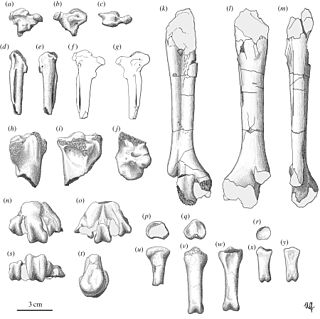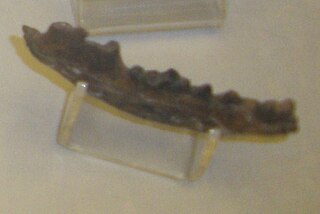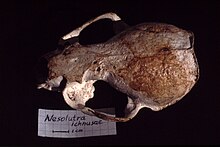
Otters are carnivorous mammals in the subfamily Lutrinae. The 13 extant otter species are all semiaquatic, aquatic, or marine. Lutrinae is a branch of the Mustelidae family, which includes weasels, badgers, mink, and wolverines, among other animals.

Dicerorhinus is a genus of the family Rhinocerotidae, consisting of a single extant species, the two-horned Sumatran rhinoceros, and several extinct species. The genus likely originated from the Late Miocene of central Myanmar. Many species previously placed in this genus probably belong elsewhere.

The Sardinian pika is an extinct species of lagomorph that was endemic to the islands of Sardinia, Corsica and neighbouring Mediterranean islands until its extinction likely in Roman times. It was the last surviving member of Prolagus, a genus of lagomorph once widespread throughout Europe during the Miocene and Pliocene epochs, whose closest living relatives are pikas of the genus Ochotona.

Dwarf elephants are prehistoric members of the order Proboscidea which, through the process of allopatric speciation on islands, evolved much smaller body sizes in comparison with their immediate ancestors. Dwarf elephants are an example of insular dwarfism, the phenomenon whereby large terrestrial vertebrates that colonize islands evolve dwarf forms, a phenomenon attributed to adaptation to resource-poor environments and lack of predation and competition.

Toxodon is an extinct genus of large ungulate native to South America from the Pliocene to the end of the Late Pleistocene. Toxodon is a member of Notoungulata, an order of extinct South American native ungulates distinct from the two living ungulate orders that had been indigenous to the continent for over 60 million years since the early Cenozoic, prior to the arrival of living ungulates into South America around 2.5 million years ago during the Great American Interchange. Toxodon is a member of the family Toxodontidae, which includes medium to large sized herbivores. Toxodon was one of the largest members of Toxodontidae and Notoungulata, with Toxodon platensis having an estimated body mass of 1,000–1,200 kilograms (2,200–2,600 lb).

Gargano is a historical and geographical sub-region in the province of Foggia, Apulia, southeast Italy, consisting of a wide isolated mountain massif made of highland and several peaks and forming the backbone of the Gargano Promontory projecting into the Adriatic Sea, the "spur" on the Italian "boot".

The Sardinian dhole is an extinct insular canid which was endemic to what is now the Mediterranean islands of Sardinia and Corsica during the Middle-Late Pleistocene. It went extinct at the end of the Pleistocene around the time of human settlement of the islands.

Mammuthus lamarmorai is a species of dwarf mammoth which lived during the late Middle and Late Pleistocene on the island of Sardinia in the Mediterranean. It has been estimated to have had a shoulder height of around 1.4 metres (4.6 ft). Remains have been found across the western part of the island.

Tyto robusta was a prehistoric barn-owl. It lived at what is now Monte Gargano in Italy, and was an island throughout much of the Neogene when sea levels were higher. The owl's remains date back to the Miocene-Pliocene boundary 5.5 to 5 million years ago. The fossil bones are about 60% as long again as a modern barn owl, giving a total length of about 50–65 cm for T. robusta. This owl provides an interesting case study of evolution and insular gigantism.

Prolagus is an extinct genus of lagomorph. Over 20 species have been named, and the genus was abundant and widespread in Europe during the Neogene. However, by the end of the Middle Pleistocene, it was confined to a single species, the Sardinian pika, on the Corsica, Sardinia, and surrounding islands, where it survived into historical times. In North Africa and Western Asia, the genus is known from the Miocene and Pliocene. The scientific name may mean "before hares" or "primitive hares". Its taxonomy is disputed, with it either being considered a member of the family Ochotonidae, which includes living pikas, or the only member of the family Prolagidae.
Cyrnaonyx is an extinct genus of Lutrinae, otters from the Pleistocene. It was originally described by Helbing based on materials from France and he also attributed material from Corsica to it. The latter appeared to belong to another species and genus, Algarolutra majori. The only species of Cyrnaonyx is C. antiqua. It is known from the Pleistocene of Europe: France, Germany, Netherlands, Southern England and probably Italy.

Megalenhydris barbaricina is an extinct species of giant otter from the Late Pleistocene of Sardinia. It is known from a single partial skeleton, discovered in the Grotta di Ispinigoli near Dorgali, and was described in 1987. It was larger than any living otter, exceeding the size of South American giant otters (Petrolutra), which can reach two meters in length. The species is one of four extinct otter species from Sardinia and Corsica. The others are Algarolutra majori, Lutra castiglionis and Sardolutra ichnusae. It is suggested to have ultimately originated from the much smaller European mainland species "Lutra" simplicidens, which may be more closely related to Lutrogale than to modern Lutra species. The structure of the teeth points to a diet of bottom dwelling fish and crustaceans. A special characteristic of the species is the flattening of the first few caudal vertebrae. This might point to a slightly flattened tail.
Algarolutra is an extinct endemic genus of otter from the Pleistocene of Corsica and Sardinia. The single species A. majori was originally attributed to the genus Cyrnaonyx and its type species C. antiqua, which was based on fossils from Corsica and also from mainland France. From mainland Europe, only lower dentition was known, whereas from Corsica and Sardinia only upper dentition was known. When a Cyrnaonyx antiqua fossil with both upper and lower dentition was found in England, it became clear that the species majori was too different to keep even in the same genus and the genus Algarolutra was described. appearing to belong to separate genera. A. majori is known only from very sparse evidence.

Rhagamys is an extinct genus of rodents in the subfamily Murinae, the Old World mice and rats. The genus was established by the Swiss zoologist Charles Immanuel Forsyth Major to accommodate Rhagamys orthodon, which is the only species in the genus. It was endemic to the Mediterranean islands of Corsica and Sardinia, descending from Rhagapodemus, which had colonised the islands around 3.6 million years ago. Its closest living relatives are of the genus Apodemus, which includes the field and wood mice.

Praemegaceros is an extinct genus of deer, known from the Pleistocene and Holocene of Western Eurasia. Praemegaceros is considered to be a genus of "giant deer", with many species having an estimated body mass of around 400 kilograms (880 lb), considerably larger than most living deer.

Garganornis is an extinct genus of enormous flightless anatid waterfowl from the Late Miocene of Gargano, Italy. The genus contains one species, G. ballmanni, named by Meijer in 2014. Its enormous size is thought to have been an adaptation to living in exposed, open areas with no terrestrial predators, and as a deterrent to the indigenous aerial predators like the eagle Garganoaetus and the giant barn owl Tyto gigantea.

Talpa tyrrhenica, also known as the Tyrrhenian mole, is an extinct species of mole belonging to the genus Talpa. It was endemic to the Mediterranean islands of Corsica and Sardinia during the Pleistocene epoch.
Microtus (Tyrrhenicola) henseli is an extinct species of vole belonging to the genus Microtus that was endemic to Sardinia and Corsica during the Pleistocene and Holocene.

Enhydrictis is a genus of extinct mustelid, belonging to the subfamily Galictinae. The type species, and best known, is Enhydrictis galictoides from the Pleistocene of Sardinia and Corsica. Some authors attribute species from mainland Eurasia to the genus, but this is disputed, with others considering the genus endemic to Sardinia-Corsica.

Pannonictis is a genus of extinct mustelids. It is first known from the very Late Pliocene and survived until the end of the Villafranchian, and is most commonly recorded from deposits between 2.6 and 1.4 Ma. Remains of Pannonictis have been found throughout Eurasia, from the Iberian Peninsula to eastern China.























